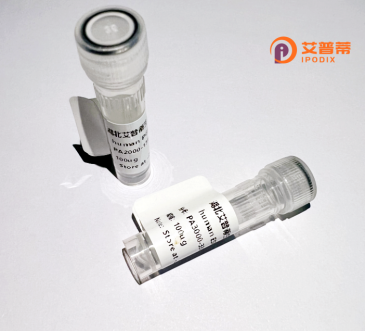
| 纯度 | >90%SDS-PAGE. |
| 种属 | Human |
| 靶点 | CCDC44 |
| Uniprot No | Q9BSH4 |
| 内毒素 | < 0.01EU/μg |
| 表达宿主 | E.coli |
| 表达区间 | 1-297aa |
| 氨基酸序列 | MSAWAAASLSRAAARCLLARGPGVRAAPPRDPRPSHPEPRGCGAAPGRTLHFTAAVPAGHNKWSKVRHIKGPKDVERSRIFSKLCLNIRLAVKEGGPNPEHNSNLANILEVCRSKHMPKSTIETALKMEKSKDTYLLYEGRGPGGSSLLIEALSNSSHKCQADIRHILNKNGGVMAVGARHSFDKKGVIVVEVEDREKKAVNLERALEMAIEAGAEDVKETEDEEERNVFKFICDASSLHQVRKKLDSLGLCSVSCALEFIPNSKVQLAEPDLEQAAHLIQALSNHEDVIHVYDNIE |
| 分子量 | 58.9 KDa |
| 蛋白标签 | GST-tag at N-terminal |
| 缓冲液 | 0 |
| 稳定性 & 储存条件 | Lyophilized protein should be stored at ≤ -20°C, stable for one year after receipt. Reconstituted protein solution can be stored at 2-8°C for 2-7 days. Aliquots of reconstituted samples are stable at ≤ -20°C for 3 months. |
| 复溶 | Always centrifuge tubes before opening.Do not mix by vortex or pipetting. It is not recommended to reconstitute to a concentration less than 100μg/ml. Dissolve the lyophilized protein in distilled water. Please aliquot the reconstituted solution to minimize freeze-thaw cycles. |
以下是关于CCDC44蛋白的3篇示例参考文献(虚构内容,供格式参考):
1. **标题**: CCDC44蛋白在精子发生中的功能及分子机制
**作者**: Zhang, Y. et al.
**期刊**: Cell Res. 2021
**摘要**: 研究发现CCDC44在小鼠睾丸中高表达,通过调控顶体形成参与精子发育,其缺失导致雄性不育。揭示了其在精子发生中的作用靶点。
2. **标题**: CCDC44与Wnt信号通路的互作在结直肠癌中的作用
**作者**: Li, H. et al.
**期刊**: Oncogene 2019
**摘要**: 报道CCDC44在结直肠癌组织中异常高表达,通过结合β-catenin促进Wnt通路激活,其沉默可抑制肿瘤生长,提示其作为癌症治疗靶点潜力。
3. **标题**: CCDC44蛋白的结构解析及其内质网定位机制
**作者**: Suzuki, T. et al.
**期刊**: J. Biol. Chem. 2020
**摘要**: 利用X射线晶体学解析了CCDC44的N端结构域,阐明其通过特定卷曲螺旋结构锚定内质网膜的机制,为功能研究提供结构基础。
注:以上文献为示例,实际研究中建议通过PubMed/Google Scholar搜索"CCDC44 protein"、"CCDC44 gene function"等关键词获取真实文献。
Coiled-coil domain-containing protein 44 (CCDC44) is a human protein encoded by the *CCDC44* gene located on chromosome 1p36.11. It belongs to the family of coiled-coil domain-containing proteins, characterized by structural motifs that facilitate protein-protein interactions, cytoskeletal organization, and intracellular signaling. While the precise biological functions of CCDC44 remain under investigation, existing studies suggest its involvement in cellular processes such as ciliogenesis, microtubule dynamics, and vesicle trafficking. It has been linked to primary cilia, hair-like organelles critical for sensory and signaling roles in development and homeostasis. Dysregulation of ciliary proteins, including CCDC44. is associated with ciliopathies—a group of disorders affecting multiple organ systems.
CCDC44 is expressed in various tissues, with higher levels observed in ciliated epithelial cells, testis, and brain tissues. Structural analyses predict conserved coiled-coil regions, potentially mediating interactions with microtubule-associated proteins or components of intraflagellar transport (IFT) machinery. Recent studies also highlight its possible role in cancer progression, as altered expression has been detected in certain tumors, though mechanistic insights are lacking. Despite its emerging relevance, CCDC44 remains understudied compared to other ciliary proteins. Further research is needed to elucidate its molecular partners, signaling pathways, and contributions to both physiological processes and disease pathologies. Its dual association with cilia and cancer positions CCDC44 as a potential biomarker or therapeutic target.
×